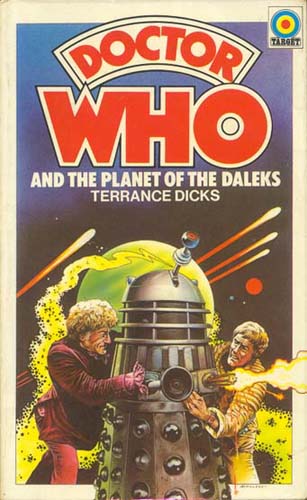Planet of the Daleks
Doctor Who and The Planet of the Daleks

|
Planet of the Daleks |
Target novelisation Doctor Who and The Planet of the Daleks |

|
| Author | Terrance Dicks |  |
| Published | 1976 | |
| ISBN | 0 426 11252 0 | |
| First Edition Cover | Chris Achilleos |
| Back cover blurb: Jo peered through the panel and saw - nothing. Yet someone had entered the cabin. She could hear hoarse breathing and stealthy padding footsteps. A beaker rose in the air of its own accord, then dropped to the floor... THE INVISIBLE ENEMY After pursuing the DALEKS through Space, DOCTOR WHO lands on the Planet of Spiridon, in the midst of a tropical jungle... and finds more than Daleks. Vicious plants spitting deadly poison, invisible Spiridons attacking from all sides and, in hiding, a vast army waits... for the moment to mobilise and CONQUER. |
A Haiku by Finn Clark Updated 12/5/20
I've always liked this.
Works better than on TV.
Makes Nation look good.
So what does a Dalek look like? by Tim Roll-Pickering 26/1/04
Upon opening this novelisation the seasoned Target reader will note that there is a complete break in continuity with Doctor Who and the Space War. That book altered the ending so that the Doctor was not shot at the climax and announced he was going after the Daleks, but here the book opens with the Doctor close to death after "an ambush with the Daleks" (although later on Jo expresses complete surprise at the Daleks' presence). It's a sign that Dicks is strongly following the televised version, indeed so strongly that all the cliffhangers are present at the end of the relevant chapters, but also a sign of Target's willingness to allow the novelisations to contradict each other heavily and confuse readers. Unless I've overloooked something, Dicks also completely fails to describe what a Dalek actually looks like, leaving the reader to rly upon existing knowledge and the cover, though there is at least a description of what the Dalek Supreme looks like. (In an interesting attempt to reconcile the Nation and Whitaker visions of the Dalek hierarchy, Dicks specifies that the Dalek Supreme is head of the Supreme Council and beneath the Emperor.)
Although this is a predominantly straightforward translation of the camera scripts into a book, there is still much to recommend about it. Whereas on television Spiridon was for the most part a world of rubber trees, lit by studio lights, here we get descriptions of a terrifying world, full of true hostility, creating an environment of real tension and fear. All of the characters are fleshed out, putting real drama into the confrontations between Taron or Vaber, or outlining how Taron and Rebec were engaged on Skaro but they find they react to each other very differently on Spiridon. The Thals are people on a suicide mission and few punches are spared. Equally the violence is stronger, with the Daleks now firing energy, producing smoking corpses, rather than the clean video effect seen on television. This is how the story should have been done, though it would have produced howls of complaints had they tried to screen it at teatime.
The climax of the story retains the weakness that is clear on television, with the Dalek Supreme announcing immediate plans to have the Dalek army recovered from the iceano. A simple addition could enhance this, something along the lines of:
But the Supreme Command never dispatched any rescue ship. The Daleks on Spiridon were abandoned for all eternity.
Otherwise there's little depth to this novel, but with six episodes to cover and only 119 pages there isn't really the space to provide much. Instead this is a fast paced novelisation that can be read extremely quickly and still provide much entertainment. Doctor Who and the Planet of the Daleks is intended to be an all out action adventure to be read quickly and preserve the story in the printed form. Here it succeeds and is well recommended. 7/10